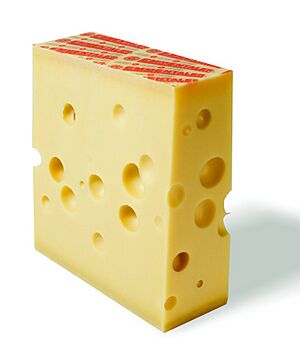Eyes (cheese) facts for kids

Have you ever wondered about the round holes in your Swiss cheese like Emmentaler? These holes are called eyes! You can also find them in some Dutch cheeses. These eyes are actually tiny bubbles of carbon dioxide gas. They form because of special bacteria working hard inside the cheese.
Contents
How Eyes Form in Swiss Cheese
In Swiss-type cheeses, the eyes appear thanks to a specific type of bacteria called Propionibacterium freudenreichii subsp. shermanii. These tiny helpers eat something called lactic acid that is naturally in the cheese.
The Bacteria's Special Meal
When these bacteria eat lactic acid, they create new things. They make propionic acid, acetic acid, water, and most importantly, carbon dioxide gas. It's this carbon dioxide gas that makes the holes!
The process looks a bit like this:
- Lactic acid (what the bacteria eat)
- Turns into: Propionic acid + Acetic acid + Carbon dioxide + Water
Where the Bubbles Go
The carbon dioxide gas starts to build up in the cheese. It looks for the softest spots in the cheese, which is called the curd. When enough gas gathers in one spot, it forms a bubble. These bubbles then become the "eyes" we see.
Not all the gas stays in the holes, though! Some of the carbon dioxide stays dissolved in the cheese itself, and some of it escapes into the air.
How Eyes Form in Dutch Cheese
In Dutch-type cheeses, the eyes also form from carbon dioxide gas. But here, different bacteria are responsible. These bacteria are called lactococci.
The Lactococci's Role
These lactococci bacteria are special because they can use something called citrate. When they break down citrate, they also produce carbon dioxide gas. Just like in Swiss cheese, this gas then creates the bubbles that become the eyes in Dutch cheeses.

